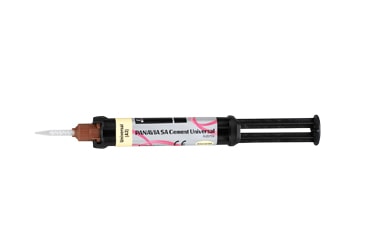By Peter Schouten, Technical Manager Kuraray Europe Benelux
Kuraray Noritake’s self-adhesive cement series, PANAVIA™ SA Cement Universal, has evolved through several stages of development since it was first introduced as “CLEARFIL™ SA Cement”. Over time, various improvements have been implemented, bringing us to our latest product: PANAVIA™ SA Cement Universal. Improvements include: strengthening of the bonding power to dental tissue, increasing the storage temperature to room temperature and extending the shelf life to three years. What remained the same – the easy removal of any excess cement, the moisture tolerance and the integration of the original MDP monomer.

The original MDP enables PANAVIA™ SA Cement Universal to be bonded to dental tissue as well as to metals and zirconia ceramics. Until recently, the chemical bonding of glass-based materials such as porcelain, glass ceramics, including lithium disilicate, and composite, was only possible with an additional silane-based primer.
With the introduction of PANAVIA™ SA Cement Universal the silanisation step has become redundant. Instead, the silane has been incorporated into the PANAVIA™ SA Cement Universal paste. As a result, there is only one single universal procedure, without the need for separate primers.

LCSi
Adding silane to the paste sounds easy. However, there are some limiting factors. For example, keeping silane in the form of γ-MPS (γ-methacryloxypropyltrimethoxysilane) active for a long time is a challenge. This is partly due to γ-MPS’ hydrophilic nature. Contact with water under acidic condition results in hydrolysis of alkoxy groups of silane. Therefore, it is best to use a more hydrophobic and thus stable silane and to avoid bringing it into contact with water and acid prematurely.
We have been using a long-chain silane (LCSi) for some time in a number of our superior composites, such as CLEARFIL™ MAJESTY™ Posterior and CLEARFIL™ MAJESTY™ ES Flow. However it’s the first time we have used it in a cement.
This unique silane has long hydrocarbon spacer (the hydrocarbon chain between the silanol group and the methacrylate group) which makes it more hydrophobic and stable than the small γ-MPS molecule. The reaction with the silica particles in the glass-based materials is expected to be also more orderly and faster. The result is a more optimally bonded surface with a greater resistance to hydrolysis.
A great deal of thought has gone into combatting the degradation of silanes in PANAVIA™ SA Cement Universal. It was decided to separate the more hydrophilic components from the hydrophobic ones so they only come together when the paste is mixed. This is why we are able to achieve a three-year shelf life, even when stored at room temperature.
Research
It’s not only in-house data that show comparable or even better bonding of PANAVIA™ SA Cement Universal to glass-based materials, than with its previous version, PANAVIA™ SA Cement Plus, in combination with CLEARFIL™ CERAMIC PRIMER PLUS. The first results from independent research are also strongly supporting this.
With PANAVIA™ SA Cement Universal, there is now a self-adhesive resin cement on the market that allows virtually all indirect materials to be bonded directly without the intervention of primers or bonding.
PANAVIA V5 |
 |
| VIEW PRODUCT |
PANAVIA SA Cement Universal |
 |
VIEW PRODUCT |